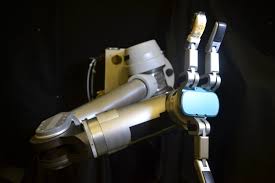Robotic skin can bring inanimate objects to life: So friends, When we consider skin, we think pictures of a thin epidermis that is intended to ensure what's underneath — whether it be by offering a shield against microbes, infections, and other dreadful stuff or by enabling us to manage our temperature through perspiring. In any case, imagine a scenario where your skin wasn't only an external layer of keen security, yet really the organ that manages and drives your body's development. That, basically, is the theoretical reason for another task from Yale researchers — just rather than tissue-based natural skin, they've built up a "robotic skin can bring inanimate objects to life", for example, toys, into working robots.
Robotic skin that can bring your inanimate objects to life
It's called OmniSkins, and it's the brainchild of partner educator Rebecca Kramer-Bottiglio and her associates at Yale University. The main thing about OmniSkins is its extraordinary adaptability—it's a broadly useful framework in view of no particular undertaking. It empowers generally lifeless things to move or gives an additional lift to robots or creatures in require. In the long run, the electric skin could be utilized to make more powerful inquiry and-safeguard robots, enable locomotion in everyday objects, and enhance wearable or assistive gadgets. An investigate the OmniSkins venture, which was fundamentally supported by a NASA research grant, was published today in Science Robotics.
Kramer-Bottiglio came up with this thought a couple of years prior when NASA requested that engineers improve and more flexible delicate automated frameworks. For NASA, the requirement for this sort of tech is self-evident. Space travellers could utilize OmniSkins, or something like it, to adjust and reuse devices locally available at the International Space Station. A mechanical arm, for instance, could be produced using a bit of froth. All the more reason, the framework could be utilized to make a delicate, ball-shaped Mars rover capable of rolling and bouncing over the Red Planet’s difficult surfaces.
OmniSkins is produced using versatile sheets installed with sensors and actuators. The adaptable sheets can be wrapped or appended to a delicate, flexible surface, for example, a soft toy or a froth tube. The skins can "animate" these items by applying power to their surface, prompting particular developments.
"We can take the skins and fold them over one question play out an assignment—velocity, for instance—and after that take them off and put them on an alternate protest play out an alternate errand, for example, getting a handle on and moving a protest," said Kramer-Bottiglio in an announcement. "We would then be able to take those same skins off that question and put them on a shirt to make a functioning wearable gadget."
The robotic skin cannot bring inanimate objects to life, but it can also likewise detect the "pushback" from an object to know how much power is expected to product movement. The movement accomplished by a objects "relies upon the connection between the measurements, material properties, and power capacities of the skin and the measurements and firmness attributes of the body," the authors write in the study. The robots can be controlled remotely by an administrator or by utilizing worked in light sensors.
In tests, the system permitted a stuffed toy horse to move on each of the four legs, and a cylinder to move like an inchworm. It was additionally used to make a gripper equipped for getting and moving articles, and a wearable gadget that, when worn as a shirt, revises poor postures.
As noticed, the quality of this tech lies in its flexibility, as most mechanical frameworks are ordinarily single reason in scope. With these robotic skins, however, one could create a different kind of robots, and even alter their functions on the fly. Different skins could be connected to a similar object, expanding functionality even after the further allowance for more complex movements. The framework is lightweight, effectively transported, and can be utilized on a wide assortment of materials. Truth be told, the analysts say OmniSkins could even be utilized on folded chunks of paper and balloons.
Conclusion
Looking forward, the group might want to streamline the significant significantly further, and potentially make parts utilizing a 3D printer.



 Whatsapp group link
Whatsapp group link


 Posted in:
Posted in: 
2 Comments:
Very Nice Article
thank you
Post a Comment